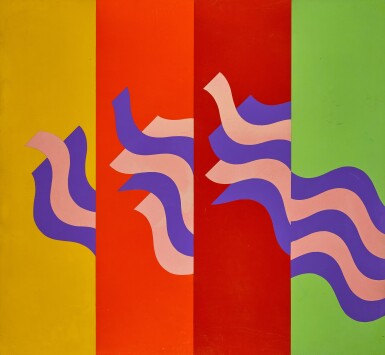
Mohamed Melehi
Composition
Lot Closed
October 20, 02:09 PM GMT
Estimate
70,000 - 90,000 GBP
Lot Details
Description
Mohamed Melehi
Moroccan
1936-2020
Composition
signed and dated 1978 (on the reverse)
cellulose on panel
110 by 120cm., 43¼ by 47¼in.
framed: 116.1 by 126.1cm., 45¾ by 49⅝in.
Private Collection, Morocco (acquired directly from the artist)
Acquired from the above by the present owner
Michel Gauthier, Melehi, 2019, Skira, illustrated in colour p. 113
"Conscious of the fact that I needed to represent Africa —too huge of a task, really—I wanted to create a form that, while traditional (the wave appears in all African art), while new (it is structurally modern), symbolizes a determined situation: despite its bloodthirsty, metallic, and programmed oppression, the dynamic spirit of this continent (its ‘SOUL’) rises up forcefully towards the sky."
Mohamed Melehi was a multi-media artist who dedicated his life to art and excelled in reinvigorating Morocco’s post-colonial contemporary art scene. Born in the coastal town of Asilah in 1936, it is evident his formative years left long lasting impression on the artist, as it would inspire his most recognisable motif, the waves.
The innate curiosity of Melehi led the artist to seek out knowledge and the constantly ameliorating approach to art outside of Morocco. Following the Revolution of the King and the People, Melehi graduated from the École des Beaux-Arts, Tétouan, Morocco in 1955. The artist then continued his fine art studies in Europe through the late 1950s, and in 1962, he travelled to the United States to take up the position of assistant professor in the painting department at Minneapolis Institute of Art. After one semester, a grant from the Rockefeller Foundation facilitated the artist’s move to New York to study at Columbia University. This move to New York proved to be instrumental in the development of Melehi's oeuvre. Inspired by the city and the non-traditional approach to art adopted by artists around him, Melehi’s signature motif, the waves, which harked back to his formative years in Asilah, first made its appearance at this time. Melehi’s innovation in New York established his name in the US and culminated in the inclusion of his works in two influential group shows in 1963, the Hard Edge and Geometric Painting and Sculpture exhibition at MoMA and Formalists at the Washington Gallery of Modern Art.
The grant from the Rockefeller Foundation stipulated Melehi's return to Morocco on completion of his studies, to apply what he had learned in the West. Upon his return in 1964, Melehi joined the Casablanca School of Fine Arts, where he was a professor until 1969. During his professorship at the Casablanca School, Melehi collaborated with artists and activists, such as Farid Belkahia and Mohammed Chabâa, in revolutionising the faculty’s curriculum. Together, they pioneered modern abstract painting and revitalised the contemporary art scene in Morocco, impressing upon their students the importance of amalgamating Modernist ideas with local sources, such as Amazigh rugs, leatherwork, tattoos and jewellery.
"during the period from 1975-87, the art works and paintings I created were executed through a repetitive, industrial method, in solidarity and sympathy with the proletariat, thereby abandoning the conventional painting preferred by the bourgeoisie. I wanted to simplify artistic expression in order to communicate with the masses, as opposed to pandering to the elitist taste of ornamentation."
This process of revitalising the contemporary art scene in Morocco expanded beyond the period of his professorship at the Casablanca school. In 1978, Melehi partnered with Mohamed Benaissa, the mayor of his hometown Asilah to establish the Al Mouhit Cultural Association, a non-political organisation, with purely cultural
objectives. This culminated in the formation of the Cultural Mussem of Asilah, a yearly arts festival. The festival is held till this day, and is famed for its ephemeral outdoor murals, many of which were painted by Melehi. Asilah, a small town with a population of 30,000 people saw a growth in the number of visitors to the town during the inaugural festival. The project was successful in revitalising Asilah, as well as demystifying de facto art.
"The wave meant music and movement. It is communication in space (sound waves, visual waves, video-tape). It represents continuity, sky, woman, sensuality, water, pulsating rhythm. It is calm."
In the 1970s, when the present lot was painted, we began to see a shift from Melehi’s linear paintings to the iconic flame and wave shaped undulations that are unique to his opus. These new wave motifs, which embodied a symbolism that was both personal and political, developed along with his programme of divergent geometry. His multiple and overflowing variations on the “wave” suggest cosmic relations, playing out between the sun, the moon, the sea, the horizon; but also new possibilities for transnational solidarities and utopias. The interplay between earth and heaven or fire and wind, allude to Melehi’s bold spirit – in the assurance of his colour delineations it feels embodied in the panel. He also explored this pattern beyond painting, through prints, posters, and books, in his role as a cultural activist with organisations such as the Union of Arab Plastic Artists, which met throughout the 1970s in Damascus, Rabat, and Baghdad – where Melehi and his Casablanca colleagues participated in the first pan-Arab Biennale, in 1974.
"The wave is force, strength of sensuality; it is water, it is fire. If you look through traditional African art, there is always a wave, and I took the wave many years ago as my alphabetic tool."
Bibliography:
Michael Gauthier, Melehi, 2019, p. 116-140
Mohamed Melehi in conversation with Morad Montazami at The Mosaic Rooms, London, 6 June 2019, http://www.thirdtext.org/melehi-montazami
Abu Dhabi Music & Arts
Foundation, Barjeel Art Foundation, Sky Over The East Works from the Collection of Barjeel Art Foundation International
Museum Day 2014 , p. 74
You May Also Like










